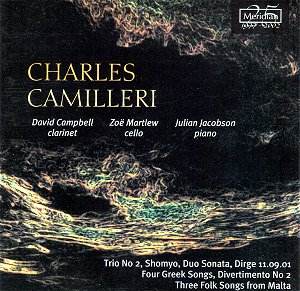Charles
Camilleri is a versatile and prolific composer whose huge and
varied output ranges from short didactic pieces to large-scale
choral, orchestral and organ works. He was quite prolific in his
late teens when he composed a huge amount of short piano sonatinas
(many of them are available on Olympia OCD 478 and OCD 465 superlatively
played by Murray McLachlan) as well as other works such as the
Four Greek Dances for clarinet and piano heard here.
This and the Three Maltese Folk Songs are simple,
attractive miniatures in folk-like idiom, much in the same vein
as Bartokís lighter pieces. Originally written for piano in the
1950s, Three Folk Songs from Malta were reworked
in 1971 for violin and piano (as heard in ASV CD DCA 1040) and
for clarinet and piano as heard here. Divertimento No.2,
originally composed in 1957, was later somewhat enlarged at Jack
Brymerís request. In this delightfully extrovert piece, Camilleri
turns to jazz rather than to his Mediterranean background which
imbues so much of his output.
I
have recently reviewed a recording of the original version of
the Duo Sonata written in 1998 for Jan Guns (on
Phaedra 92020). In 2000, Camilleri arranged (or rather considerably
rewrote) the vibraphone part so that the work may now be performed
as a duo for bass clarinet and piano. Both versions work remarkably
well, though each has its own sound qualities. A most welcome
addition to the repertoire for bass clarinet.
The
short, deeply moving Dirge 11.09.01 does not call
for any particular comments. The music makes its point in clear,
direct terms, with remarkable restraint, which makes it the more
poignant.
Shomyo
for a solo wind instrument (flute, oboe or clarinet) is a short
ritualistic meditation appropriately based on a pentatonic scale.
By
far, the most substantial work here is the Trio No.2
for clarinet, cello and piano, in four concise movements of which
the third one is the most developed and the most complex. The
music inhabits an altogether more astringent harmonic world than
any of the other works heard here, with more angular tunes and
mild dissonance, though it is generously communicative, as is
so much of Camilleriís music. (Incidentally, the Trio No.1
"New York" for clarinet, violin and piano, is
available on Meridianís earlier all-Camilleri release CDE 84407
which I have not heard so far.)
This
attractive and varied selection of clarinet works by Camilleri
is superbly well served both by the performers and the recording.
All these pieces make for a quite enjoyable disc that will, no
doubt, appeal to Camilleriís admirers whereas others, I am sure,
will find much to enjoy. I for one relished it from start to finish.
Hubert
Culot
